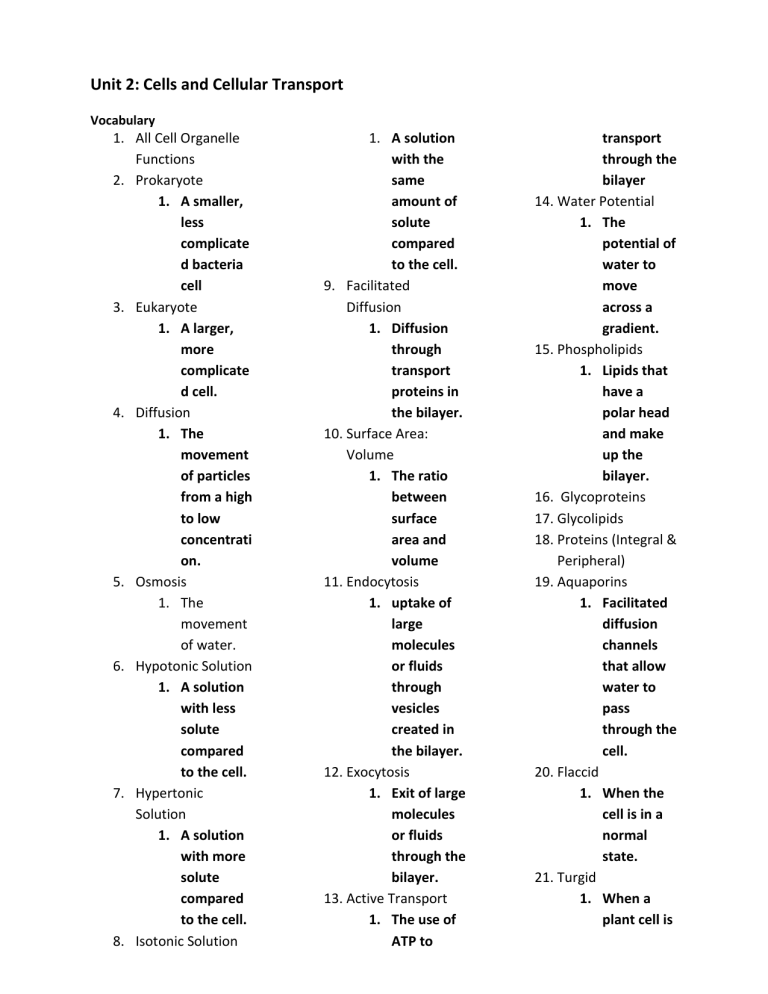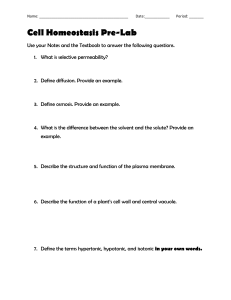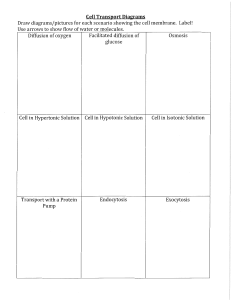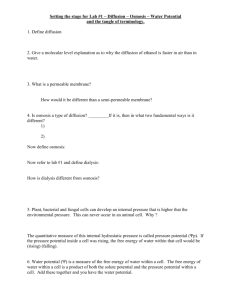
Unit 2: Cells and Cellular Transport Vocabulary 1. All Cell Organelle Functions 2. Prokaryote 1. A smaller, less complicate d bacteria cell 3. Eukaryote 1. A larger, more complicate d cell. 4. Diffusion 1. The movement of particles from a high to low concentrati on. 5. Osmosis 1. The movement of water. 6. Hypotonic Solution 1. A solution with less solute compared to the cell. 7. Hypertonic Solution 1. A solution with more solute compared to the cell. 8. Isotonic Solution 1. A solution with the same amount of solute compared to the cell. 9. Facilitated Diffusion 1. Diffusion through transport proteins in the bilayer. 10. Surface Area: Volume 1. The ratio between surface area and volume 11. Endocytosis 1. uptake of large molecules or fluids through vesicles created in the bilayer. 12. Exocytosis 1. Exit of large molecules or fluids through the bilayer. 13. Active Transport 1. The use of ATP to transport through the bilayer 14. Water Potential 1. The potential of water to move across a gradient. 15. Phospholipids 1. Lipids that have a polar head and make up the bilayer. 16. Glycoproteins 17. Glycolipids 18. Proteins (Integral & Peripheral) 19. Aquaporins 1. Facilitated diffusion channels that allow water to pass through the cell. 20. Flaccid 1. When the cell is in a normal state. 21. Turgid 1. When a plant cell is full with water. 22. Lysed 23. Plasmolysed Objectives 1. ALL cell organelles found in packet from class (be able to identify function and label on diagram). Do NOT need to rewrite all functions. See quizlet and your packet for this objective. 2. Explain why cells are small. ● To decrease the surface area to volume ratio. When multiple cells make up a structure, one cell failing does not compromise the whole structure. 3. Know how to calculate Surface area : Volume ratio and state whether it is better for it to be large or small. ● better for it to be small. 4. Prokaryote vs. Eukaryote: Differences? Similarities? ● Prokaryotes do not have a nucleus to store their genetic information, eukaryotes do. Prokaryotes are single celled and eukaryotes are multicellular. 5. Plant vs. Animal Cells: Differences? Similarities? ● Plant cells have a cell wall, a large vacuole that gives it structure, plants have a chloroplast, animal cells have lysosomes. 6. Cell Membrane Structure: State functions of the following and be able to label on diagram: o Phospholipids, Glycoproteins, Glycolipids, Cholesterol, Carbohydrates, Proteins (Integral & Peripheral), aquaporins. 7. Movement Across Cell Membrane: For each, know definition, which way molecules will move, whether or not uses cell energy, example of each. o 1. Diffusion ▪ movement from high to low o 2. Osmosis ▪ Hypertonic, Hypotonic, Isotonic Solutions ● Hypertonic water moves out of the cell, hypotonic water moves into the cell, iso no water movement ▪ Differentiate between “normal” conditions for plant and animal cells using correct terminology. ● turgid for plants and normal for animal cells o 3. Facilitated Diffusion ▪ diffusion through a transport protein o 4. Active Transport ▪ Endocytosis (Phagocytosis vs. Pinocytosis) ● phagocytosis is taking in solids, pino is talking in liquids ▪ Exocytosis ● taking out 8. Water Potential o What is it? ▪ the potential energy for movement of water o How to calculate? ▪ potential of solute plus pressure o Which way does water move? ▪ from high to low water potential o What does the water potential tell you about how much solute is in the solution/cell? ▪ a higher water potential means that there is more solute concentration in the cell. o In what type of situations is pressure potential important? ▪ when cells are in different states of rigidity, ie. turgid cells vs flaccid cells. o Be able to predict movement of water given a particular scenario. Know how to solve all problems in Water Potential Packet. 9. Diffusion/Osmosis Lab: All concepts/procedures in the lab are fair-game for both MC and FRQ. Be sure you understand how and why we conducted all parts of the lab. Also know how to interpret the graph you constructed for sucrose concentrations and apply similar techniques to other situations.




